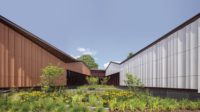Princeton, New Jersey
In an age of lightning-fast mobile devices that provide access to information with the swipe of a finger, books can seem archaic. So libraries, once bastions of the printed word, have evolved to fit the new, digitized needs of their users while continuing to do something the Internet cannot: provide a centralized, three-dimensional space dedicated to writing, reading, and research. This was the impetus for revamping Princeton University's 3,100-square-foot Julian Street Library, a media center and social lounge for students belonging to Wilson, one of Princeton's six residential colleges.
To foster a sense of place in the renovated reading room, New York'based Joel Sanders Architect (JSA) devised a carefully considered lighting scheme that creates two discrete “zones,” one for communal studying and reading, the other for relaxing. In doing so, JSA has given the students of Wilson College a more modern, comfortable place to work and gather.
The library, which occupies a 1960s-era concrete building called Wilcox Hall, was founded as a “gentleman's library,” says Wilson College master and English professor Eduardo Cadava. “The idea was to fill it with the books that all gentlemen ought to be familiar with,” Cadava explains with a laugh. In its 21st-century iteration, “Princeton wanted a dynamic space that allows students to gather around digital devices,” says architect Joel Sanders.
The primary challenge presented by the old library was its compartmentalization. So JSA opened up the space by removing a masonry wall in the foyer and installing wide, tiered seats that step up toward a large communal workbench. This amphitheater-like area serves as a visual and spatial link between the entry and the main reading room, which is accessed via a ramp to the right and brings daylight beyond the entry and into the whole space. Sixteen round lighting fixtures, installed within a ceiling grid painted the same shade of bright blue as the furnishings in the space, provide an ambient glow over the seating area.
JSA carried this circular motif into the main reading room, installing disk-shaped fixtures that create pools of light along the area designated for lounging and reading (also dressed in the punchy blue of the vestibule soffit). “We thought a lot about using lighting to differentiate spaces from one another,” says Sanders. Bands of fluorescent strips above communal tables in the “quiet studying” area provide even, bright illumination. “We're also highlighting some vertical surfaces and, in doing so, making the space seem more generous overall,” says Washington, D.C.'based lighting designer George Sexton, who worked with JSA on the project. Halogen lamps highlight shelves built into the reading-room walls and give computer stations a bit of vibrancy.
All these changes have brought a welcome contemporary edge to the mid-century library, says Cadava. “We really wanted to provide students with a space that was more useful and relevant to the ways they're learning today,” he says. “It's been a real success.”
People
Formal name of building:
Location:
Completion Date:
Gross square footage:
Owner:
Architect:
Personnel in architect's firm who should receive special credit:
Architect of Record:
Engineer(s):
MEP:
Consultant(s):
General contractor:
Photographer: |
Products
Doors
Hardware
Interior finishes
Furnishings
Lighting |














